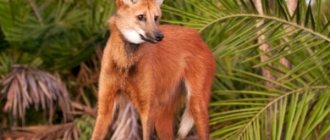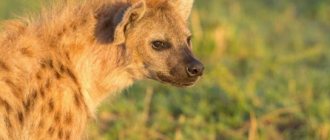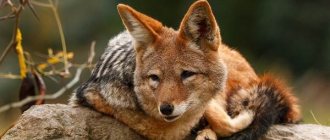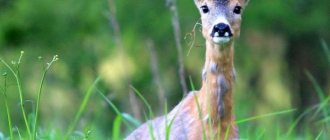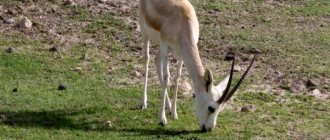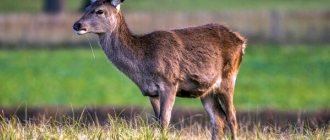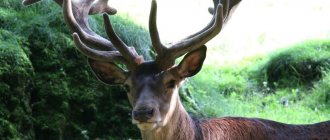- Wolf - description, structure, characteristics. What does a wolf look like?
The wolf, perhaps, is not just a predatory animal from the canine family found in our forests, but also a whole archetypal image, very familiar to us from a very early age, at least from children's fairy tales and cartoons, where he, as a rule, personifies a negative, evil character , wanting to feast on either Little Red Riding Hood, or the three little pigs, or some other fairy-tale creature. In fact, from ancient times, people’s attitude towards the wolf was ambiguous; it was either revered (at the same time feared) or demonized; we see an echo of this demonization in many children’s fairy tales. The very name of this beast “wolf” is not without reason consonant in many languages, the English “wolf”, the “Bulgarian” vylk, the Serbian “vuk”, our Ukrainian “vok” perhaps comes from the Old Slavonic word “vylk” meaning to drag, drag away, the fact is , that when dragging away prey, the wolf dragged it in front of him, hence its name.
Wolf Ancestors
According to the theory of evolution, the ancestor of the wolf was Canis lepophagus, an ancient mammal resembling a coyote and living in North America. Over time, the wolf's ancestor increased its size, including the size of its skull. The most ancient representative of the wolf family, already similar to the modern wolf, was found during the study of an early pleistocyte that existed 1.8 million years ago. Although he was only similar to the modern wolf, which was somewhat later - from a million to 150 thousand years ago.
In general, zoologists have discovered as many as four family trees of wolves: African, Himalayan, Indian and Tibetan lines. The Himalayan line is the oldest of them, which means that the Himalayan wolf is the most venerable representative of the wolf order, its appearance took place about a million years ago. The Tibetan wolf is conditionally the “youngest”, since it appeared “only” 150 thousand years ago.
Description, structure, characteristics
All wolves are notorious predators, there are no options here, and they are quite large predators, the largest being the gray and polar wolves: their height reaches 85 cm, body length - 150-160 cm, this does not include the tail, weight - 85-90 kg . Moreover, the harsher the habitat, the larger the animal; it is not for nothing that the largest representatives of the wolf family live in the Siberian taiga.
The smallest wolves are Arabian, their maximum height does not exceed 66 cm, and their average weight is only 10 kg. Also, in general, in all wolves, females are slightly smaller in size than males.
Outwardly, wolves look like dogs, which is not surprising, because they are their distant relatives.
The wolf's mouth has 42 teeth, including four fangs, which serve the owner to tear prey into pieces, grind bones, and the fangs are excellent for dragging the victim.
Interesting fact: all wolves are born gob-eyed, but by the third month their eyes turn orange or golden yellow. Although there are wolves who remain blue-eyed.
Wolf fur is thick and double-layered; it perfectly protects them from the cold in the cold conditions of the tundra or taiga, and also has waterproof down.
Coat colors can vary depending on the type of wolf and its habitat, with a wide variety of gray, white, brown and black colors found. Red wolves are also found. Often their color helps them blend in with their surroundings.
You may know the proverb “the wolf’s legs feed him”; it also has scientific and zoological basis, since his legs really feed him, and for this reason they are well developed, allowing him to move considerable distances in search of food. Wolves usually trot at an average speed of 10 km per hour, but the speed of a wolf chasing prey can reach 65 km per hour.
A wolf's vision is not the strongest quality, it is not very developed, and besides, it does not distinguish colors, but this deficiency is more than compensated by excellent hearing and especially charm - it can smell prey 3 km away, in general, its nose distinguishes millions of shades of smell.
Also, another characteristic feature of wolves is their famous howl, which actually has a practical meaning for them - wolves do not just fight for the moon (as was previously thought) but in such a simple way inform the members of the pack of their location, and at the same time drive away strangers.
Wolf Pack
Relations in the pack are altruistic in nature. Each animal completely subordinates its interests to common needs. Otherwise, the predator community would not have survived. Not only physical characteristics, but also psychological characteristics influence the rank of an animal. This is explained by the fact that the leader must take charge of organizing the hunt and divide the food obtained among his relatives. Older wolves are responsible for the younger ones. Juveniles unquestioningly obey the demands of their older relatives.
There are seven ranks in the pack. Management of community members occurs without forceful influence. A clear organization, distribution of roles, complete freedom of choice to be or not to be in the pack - all this makes the wolf family a highly organized, well-coordinated mechanism. The social status of wolves is associated with the age and sex of the animals. However, these indicators serve only to achieve the set goals. Having caught prey, wolves will never hunt again as long as they have food.
Unit in the pack:
- The leader plays the leading role. He bears full responsibility for the rest of his relatives. Its main tasks are a clear distribution of roles in the family, organization of actions, protection, selection of habitat, and management of hunting. The leader has the right to start eating first, but this rule can be violated by him. In some cases, an adult animal shares prey with puppies. This situation often occurs when there is a lack of food. Puppies are the future of the pack and the leader must take care of them.
The flock never disputes the right to the first piece of food.
A weakened leader will not be able to provide security to his relatives. The leader has no right to protection. In times of danger, only he decides how to act; the pack always listens to him.
- Warriors are the backbone of the pack. They provide food and safety for their relatives. When there is an external threat, only warriors enter into battle. This rank can be occupied by wolves of both sexes. However, a female with puppies never participates in guarding and obtaining food.
A senior warrior can replace the leader if he dies or for some reason cannot lead the pack. He, along with the main wolf, organizes protection and hunting.
- An adult female with experience raising wolf cubs is a mother. Its main functions are to take care of the pack's puppies. A female who has whelped does not automatically occupy this rank. When a flock is attacked, it is the mother who takes all weak relatives to safety while the warriors repel the attack.
The eldest female never competes with the main warrior, but if necessary, she takes the place of the leader. When the head of the pack dies, the most worthy animal begins to play his role. At the same time, there are no fights to identify the best contender for the status of leader.
During feeding and raising puppies, all mothers of the pack are under special care.
Reproduction occupies a special place in the life of animals. Once a year, the flock splits into pairs to reproduce. All members of the flock can reproduce. The main condition for this is awareness of one’s role in the pack. Those wolves who did not get a mate help their relatives raise their young and hunt. Pairs are always created for life. If one of the pair dies, the surviving wolf never looks for a partner again.
- A guardian is an animal that controls the wolf cubs. There are two subranks. Pestun is a young wolf who is not currently capable of becoming a warrior due to his age or is a young wolf from a previous litter. These animals completely obey their mother and follow her orders. This is how they learn to handle wolf cubs. Being a caregiver is the first stage of education that allows you to acquire the skills you need for life.
- Uncle is a male dog with no family. Helps raise young fish.
- The signalman is the eyes of the pack. It is he who alerts her to the impending threat. The received information is analyzed by more experienced wolves. Only after this is a decision made on further actions.
- The puppy bears no responsibility. His main task is complete obedience. Adult animals show him special care and guardianship.
- A disabled person is an elderly person who has the right to protection and food. Wolves always take care of their old relatives.
Habitats
Unfortunately, in our time, the wolf's habitat has noticeably decreased; in past times, wolves lived throughout the territory of Eurasia and North America, where humans lived. For example, historical chronicles indicate that during the Hundred Years' War between England and France there was such great devastation and desolation that wolves even appeared on the streets of Paris. Now, of course, you are unlikely to meet a wolf not only in the vicinity of Paris but also in other cities; they remain, and even then in small numbers, in wild places, including in our Carpathians, in the Siberian taiga.
Wolves are social animals that live in packs, which always have a pair of leaders: a male and a female. The remaining members of the pack: the offspring of the leaders, their relatives or lone wolves who have joined are subject to a strict hierarchy. A pack of wolves has its own area of territory, up to 300 square kilometers, which they mark with special odorous marks that serve as a warning to intruder wolves.
Lifestyle
Wolves live in packs that have a strict hierarchy. They usually form groups of 10-30 individuals. The leader monitors discipline, distributes responsibilities and divides the spoils. Each pack is dominated by a dominant pair. Even the weakest members of the community can count on protection and a share of the spoils.
The wolf's voice has a wide range. Each sound has many variations. Thanks to this, wolves can transmit various information to each other over a very long distance. They are even able to warn their fellow tribesmen about the approach of a person. The signal for an attack is usually given by the leader. This sound is reminiscent of the angry growl of an angry dog. Some people living in close proximity to nature have learned to distinguish the language of wolves.
Nutrition
Wolves are excellent hunters, and they hunt equally successfully both in a pack and alone. Their prey in the forest is many herbivores: moose, deer, roe deer, saigas, antelopes,
wild boars, hares, gophers. At the same time, wolves are a kind of useful orderlies of the forest, because old, weak, sick animals first come to them for dinner, thus natural selection occurs. An interesting feature of the wolf is its practical habit of hiding excess meat in reserve.
Types, photos and names
Let us describe the most interesting species of wolves in our opinion.
Red Wolf
He is the Himalayan wolf, as we mentioned above, he is the oldest of the order of wolves, since he appeared a million years ago. Outwardly, he combines the features of a wolf,
foxes and jackals. It is 76-110 cm in length, weight is 17-21 kg. It has a short, pointed muzzle and large ears. The color is red. Also distinguishing it from other wolves is the smaller number of teeth. The red wolf lives in Asia: from the Altai Mountains to the Tien Shan, but most of them live in the Himalayan Mountains, southern Iran, India and Pakistan. As a rule, it feeds on various small animals. It is on the verge of extinction.
Maned wolf
A unique representative of the wolf kingdom, its other name is guar or aguarachay, which translates as “short-tailed golden dog.” It has long hair on the back of the neck, which forms a thick mane. Outwardly very similar to a fox. The length of its body is approximately 125-130 cm, weight – 20 kg. Lives exclusively on the plains, feeding on rodents, rabbits, and armadillos. The habitat of the maned wolf is South America: Brazil, Bolivia, Paraguay.
Eastern wolf
He is also a North American timber wolf, lives in North America, especially in Canada - from Ontario to Quebec. Interestingly, it does not have its own classification; some scientists consider it a hybrid of a gray wolf with a red wolf or coyote. Its height reaches 80 cm, body weight – 40 kg.
common wolf
He is also the gray wolf - the same type of wolf that is widely known, starting with children's fairy tales. It is one of the largest representatives of the wolf kingdom and, moreover, one of the most formidable predators in our temperate latitudes. The habitat of the gray wolf is wide - the territory of Eurasia and North America; everywhere in dense and wild forests you can meet this formidable predator.
Red wolf
It is a hybrid of a gray wolf and a coyote. Red wolves are smaller than their gray relatives, but larger than coyotes, their size reaches 79 cm, weight - 40 kg. It is also distinguished by greater slenderness, more elongated ears, but shorter fur. They especially like to hunt hares,
raccoons and other small rodents, but can also attack larger prey. The red wolf lives in the eastern United States, in Texas, Louisiana, and is one of the rarest species of wolves on earth. Now, unfortunately, it is on the verge of extinction.
Tundra wolf
Living in the tundra, this species of wolf is the least studied. Outwardly similar to its closest relative, the polar wolf, but not so large, its average weight is only 42-49 kg. Like their polar relatives, they have a white coat color, which helps them blend perfectly with the white snowy landscape of the tundra itself.
polar Wolf
It is also one of the largest representatives of the wolf family, living in the extreme northern regions of our planet. It has a white color and the weight of the polar wolf can reach 95 kg. Likes to feast on small ones
lemmings and the larger Arctic muskox. During the famous lemming migrations, polar wolves may also migrate along with their favorite food.
What does it eat?
The wolf is a typical predator. It obtains its food through pursuit and attack. What does a wolf eat in the wild? The basis of its diet are ungulates. In the absence of such, animals can attack livestock and dogs. They can also feed on small animals and rodents. Wolves hunt large prey in packs, and small prey alone. They prefer to attack weak and sick animals.
What else do wolves eat? Often these predators even hunt birds. In case of hunger, they can eat their wounded relative. They can also feed on animal carcasses. In times of hunger, they eat reptiles and even plant foods.
What do wolves eat in winter? During the cold season it is very difficult to find food. At this time, predators become especially bloodthirsty. So, what does a wolf eat in winter? Their diet does not change much in the cold, but they prefer to hunt in packs at this time of year. Weaker individuals try to get closer to a person’s home in the hope of getting livestock.
Reproduction
Female wolves become sexually mature in the second year of life, males in the third, mating season for wolves usually occurs from January to April. There are frequent fights for a female between competing males, as well as mutual courtship and flirting of both males and females.
During mating, “loving” wolves leave the pack, retire, setting up a den in a secluded place. A she-wolf's pregnancy lasts 62-65 days and from 3 to 13 cubs are born at a time. True, not all of them survive; the weaker wolf cubs die.
Little wolf cubs feed on milk and burps from their mother, and after just six months of life they become able to take part in hunting.
Interesting Facts
mushrooms,” but they also drank wolf blood and wore the skins of these animals.
Video
And in conclusion, we invite you to watch an interesting film about wolves from the National Geographic channel - “The Rise of the Black Wolf.”
Author: Pavel Chaika, editor-in-chief of Poznavaika magazine
When writing the article, I tried to make it as interesting, useful and high-quality as possible. I would be grateful for any feedback and constructive criticism in the form of comments on the article. You can also write your wish/question/suggestion to my email [email protected] or Facebook, with respect, the author.
Author page
Eye color
All wolves have blue eyes at birth. But by the 3rd month it changes to gold. Although there are exceptions when wolves spend their entire lives with blue eyes.
Look - Badger - species, description, distribution, population size and predator nutrition (110 photos)
